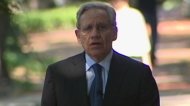6 Questions (and Answers) About the Sequester
By CHRIS GOOD | ABC OTUS News – 7 hrs ago
Nobody likes the sequester.
Even the word is enough to send shivers of fiscal panic, or sheer
political malaise, down the spines of seasoned politicians and news
reporters. And today, the sequester will almost certainly happen, a year
and a half after its inception as an intentionally unpalatable event
amid the stalemate of the debt-limit crisis in 2011.
Automatic budget cuts will be triggered across federal agencies, as President Obama will be required to order sequestration into effect before midnight Friday night. The federal bureaucracy will implement its various plans to save the money it's required to save.
Now that the sequester will probably happen, here are some questions and answers about it:
1. HOW BIG IS IT?
The cuts were originally slated for $109 billion this year, but after the fiscal-cliff deal postponed the sequester for two months by finding alternate savings, the sequester will amount to $85 billion over the remainder of the year. Over the rest of the year, nondefense programs will be cut by nine percent, and defense programs will be cut by 13 percent.
If carried out over 10 years (as designed), the sequester will amount to $1.2 trillion in total.
2. WHAT WILL BE CUT, SPARED?
Most government programs will be cut, including both defense and nondefense spending, with the cuts distributed evenly (by dollar amount) over those two categories.
Some vital domestic entitlements, however, will be spared. Social Security checks won't shrink; nor will Veterans Administration programs. Medicare benefits won't get cut, but payments to providers will shrink by two percent. The Children's Health Insurance Program (CHIP), food stamps, Pell grants, and Medicaid will all be shielded from the sequester.
But lots of things will get cut. The Obama administration has warned that a host of calamities will befall vulnerable segments of the population.
3. WHY DOES IT HAVE TO BE SO BAD?
Questions persist over whether or not it really does.
The sequester will mean such awful things because it forces agencies to cut things indiscriminately, instead of simply stripping money from their overall budgets.
But some Republicans, including Oklahoma Sen. Tom Coburn, have suggested that federal agencies have plenty of flexibility to implement these cuts while avoiding the worst of the purported consequences. Louisiana Gov. Bobby Jindal accused President Obama of trying to "distort" the severity of the sequester. The federal government will still spend more money than it did last year, GOP critics of sequester alarmism have pointed out.
The White House tells a different story.
According to the Office of Management and Budget, the sequestration law forces agency heads to cut the same percentage from each program. If that program is for TSA agents checking people in at airports, the sequester law doesn't care, and Homeland Security Secretary Janet Napolitano can't do anything about it.
Agency heads do have some authority to "reprogram" funds, rearranging their money to circumvent the bad effects. But an OMB official told ABC News that "these flexibilities are limited and do not provide significant relief due to the rigid nature of the way in which sequestration is required by law to be implemented."
4. WHEN WILL THE WORST OF IT START?
Not until April -- but some of the cuts could be felt before then.
Most of the sequester apocalypse, of which Obama's Cabinet has warned, relates to government-worker furloughs: Airport-security lines will get longer because TSA agents will work one fewer day every two weeks, thinning out the workforce; fewer commercial planes will fly because of furloughs to air-traffic controllers; prisons will be locked down because Bureau of Prisons staff will be sent home; terrorists may go undetected because fewer FBI agents and counterterrorism analysts will be working.
Those furloughs won't begin until April, at the earliest. In most cases, government agencies must give workers 30 days' notice before furloughing them. The Federal Aviation Administration (FAA), for instance, expects some of its furloughs to begin April 7, but it's still haggling with unions over notification procedures.
But other bad things could happen before then. State programs that rely on federal money will have to begin accounting for lesser funds as soon as President Obama orders the sequester into effect on Friday. Government contractors, meanwhile, will feel the cuts immediately.
5. WILL IT GET FIXED?
TBD. President Obama and congressional Republicans have each proposed their own ideas to avert the sequester, but the two sides haven't agreed yet.
At this point, the sequester is all but assured to go into effect. Obama will meet with congressional leaders Friday morning, but negotiations haven't exactly been substantive thus far.
Given the sequester's all-around unpalatability, the likeliest scenario appears to be a short-term fix after the sequester kicks in for a few weeks.
6. HOW CAN IT GET FIXED?
President Obama and his GOP counterparts, distant as they are on matters of fiscal policy, have a few remaining options to keep the sequester from wreaking its oft-alleged, oft-doubted chaos:
-
A grand deficit deal. This probably will not happen.
The sequester originally sucked $1.2 trillion out of projected federal
appropriations over the next 10 years, and an equivalent measure of
deficit savings -- it could be tax revenue, it could be spending cuts,
or it could be a combination -- is what's needed to eliminate the
sequester over the long haul.
Given how little sides have been talking over the last few weeks, it's
almost completely impossible that such a grand deal will get struck
before 11:59 p.m. on Friday, when Obama will be legally required to
order the sequester into effect.
- Give agencies more authority. As Republicans and journalists have astutely noted, the cuts aren't all that big, depending on how you count them. They're less than 2.5 percent of all government spending—although what those critics don't mention is that the cuts are concentrated in discretionary accounts, hence the nine and 13 percent reductions in nondefense and defense spending. So why not give federal agencies broader authority to rearrange their money and shrink overall spending while maintaining the most vital programs and services? If the Justice Department can save money by means other than furloughing FBI agents, why not let it?
- A temporary fix. Washington has already done this once. When Obama and Congress passed their fiscal-cliff deal in January, they delayed the sequester by finding two months' worth of deficit reduction to match the sequester's spending levels and decided to prevent the sequester from kicking in until March 1.
Republicans have reportedly fought over this, and President Obama has resisted the idea of leaving the sequester in place, even with more leeway to make the cuts less painful.
Giving agencies more flexibility poses two problems. First, it fundamentally changes the sequester by making it more palatable. When Congress and Obama agreed on it in 2011, the sequester was designed as a punishment for failing to reach a broadly acceptable deficit deal. If the cuts aren't so bad, the intent of forcing a deal will be abandoned. Second, it cedes power to the Obama administration, which members of Congress don't like. As Sen. John McCain put it in a recent interview, Senate appropriators spent many hours juggling the funds for Defense programs—why simply let Obama undo their work?
That's not how it's supposed to work. The sequester law, written into the 2011 Budget Control Act, doesn't let Obama and Congress simply buy their way out of the sequester with related savings, a few months at a time. What Obama and Congress did was to undo the sequester temporarily.
This worked because everyone agreed on it. They found $24 billion by raising taxes and cutting waste from some government programs, and that was enough to match the spending levels the sequester would have implemented. At the same time, they changed the sequester's start date, altering the original law and halting the sequester because they all agreed that was O.K.
There's no reason, legally, why that can't happen again. When President Obama addressed national TV cameras last week to protest that the sequester shouldn't be allowed to happen, he suggested that Congress pass a temporary measure to give both sides enough time to reach a long-term deal.



No comments:
Post a Comment